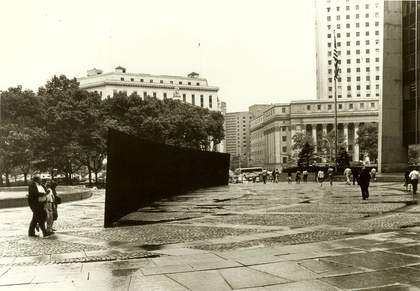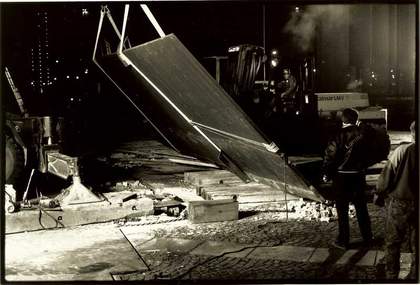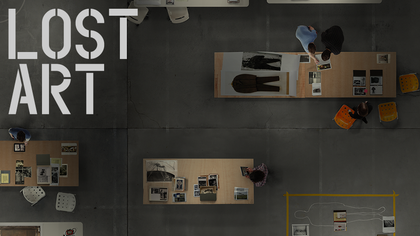Tilted Arc 1981
Richard Serra’s Tilted Arc was a massive public sculpture installed outside government buildings in Federal Plaza, New York, in 1981. It was, in effect, a wall of steel – 12 feet high and 120 feet long – that traced a subtle arc over its length and leaned slightly to one side.

View of Federal Plaza with Tilted Arc seen from the side
Photograph by Susan Swider
Courtesy of Richard Serra
Serra was honoured by the commission awarded by a panel of experts and spent two years planning it, believing the work would be a permanent addition to this busy area of the city. Unfortunately, nothing was done to prepare people for the arrival of the steel sculpture and the reaction of office workers to the piece was negative: it was immediately seen as ugly, oppressive and a ‘graffiti catcher’. Two petitions seeking the removal of the piece quickly gathered 1,300 signatures.
The body that commissioned the work, the General Services Administration (GSA), stood firm, arguing that the 1,300 signatures on the petition represented a minority given that there were 10,000 employees in the building. However, the direction of the GSA changed dramatically in 1984 with the arrival of a new Republican-appointed regional administrator, William Diamond.
Diamond arranged for a three-day public hearing about the possibility of relocating the work, and appointed himself head of a panel of adjudicators. At the public hearing 180 people spoke, including Serra, who pointed out that the work was site-specific and would not function as an artwork if moved elsewhere. He also flatly denied that the interfered with social use of the plaza. In all, 122 people, including many eminent figures from the art world, spoke in favour of retaining the piece, while only fifty-eight, mainly those working in the nearby offices, testified against it. Despite these figures, the panel voted to relocateTilted Arc. Serra sued, but the courts ruled that the GSA owned the piece and could do what it wished with it.

Removing Tilted Arc, 15 March 1989
Photo: Jennifer Kotter
Courtesy Richard Serra
The sculpture was finally removed on 15 March 1989. Cut into three parts, Tilted Arc – or, rather, what remains of it – is stored in a warehouse. The artist regards the work as destroyed because removed from its intended site. He also noted that, in disregarding his argument and considering the work as movable, the GSA had made the work ‘exactly what it was intended not to be: a mobile, marketable product’.
After Tilted Arc had been removed, Diamond proudly declared that a ‘new art form – open space’ would be exhibited in the plaza. A few benches and planters with trees were installed. Some years later when the plaza needed structural repair and renovation, a landscape architect was commissioned to enliven the space and installed a curling maze of bright green seating that offered workers the opportunity to meet and eat their lunches in the open air. The social function of the plaza had been foregrounded but the important point made by Serra during the 1985 hearing that art itself was a social function had been lost.



